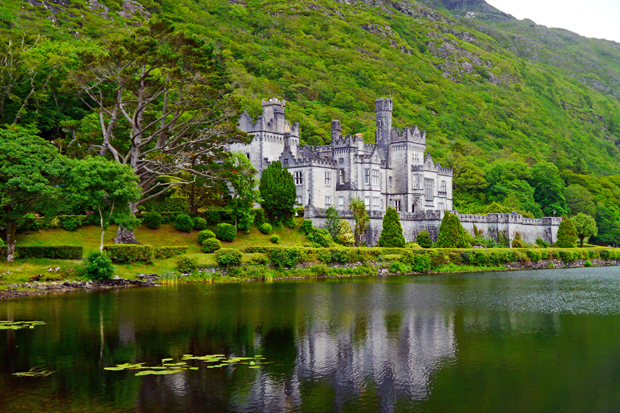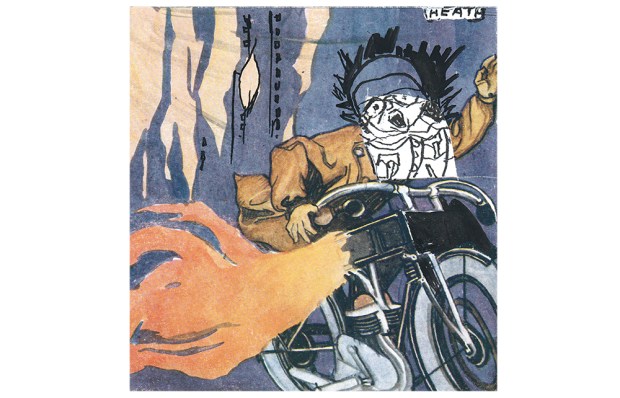After a healthy Irish lunch I drove blithely off through the streets of Roscrea, I think it was, to find that everywhere I went the populace was cheerfully waving at me, smiling, gesticulating or blowing horns. When I stopped to ask them why, I found that I had left on the roof of my car a wallet containing my entire worldly wealth, cash, credit cards and all. So paradoxically enjoyable was all this, so irresistibly amused and sympathetic were the bystanders, that I came to think of the event as a sort of leitmotif of my visit to Ireland.
For whatever else has happened to the Republic, through it all the populace has remained fun, quick, laughing and kind to foolish visitors. I was pottering around for a couple of weeks trying to sense the present feel of the country, and in most other ways found it impossible to escape the layered changes in the nature of Irishness that have occurred during my half-century of bemused acquaintance with the place. Only the charm of the Irish has defied time!
Not so long ago there lingered relics of the Republic’s very beginnings, the days of the Easter Rising and the terrible beauty, and I often used to come across burnt-out houses of the old Ascendancy, and sometimes living survivors too. I have met no Anglo-Irish gentry this time, but when the other day I was scoffing oysters on a waterfront in County Galway I looked up and lo, silhouetted on the skyline was the gaunt vestigial ruin of Tyrone House, burnt in 1920 along with its attendant chapel, about which John Betjeman once wrote
One extinguished family waits
A Church of England resurrection
By the broken, rusty gates….
Otherwise that lost and enviable ruling caste offered me no memorials, but so varied have been the fortunes of Ireland since its extinction that I could read the Republic’s more recent history in the very landscapes that I passed. Do you remember the days of the Celtic Tiger, back in the 1990s, when the Irish economy boomed and every other Irishman seemed to be suddenly rich? Well, half the roads I have been driving along are memorials to those heady times — the grand autostradas that span the island now, the astonishing tunnel that takes traffic bang under Dublin to its port — not to mention the clumped high-rise skyline of the capital itself, and the almost crazy proliferation of white bungalows and villas that altered half the countryside in a vast demonstration of New Richness.
But of course the tiger soon lost his claws, and Ireland, like all the rest of us, subsided into recession. The mementos and effects of the 2000s are everywhere still. In every last town there are boarded-up shops, and those perky little country establishments with the bright signs and the proud names are hard to find these days — especially the house-pubs that used to enliven so many country corners. Half the moral meaning of Irishness momentarily faded then, too, as some of the very bishops of the church were found to be less than saintly; even now the myriad churches often look drably neglected, and the priests and nuns who used to seem essential to the Irish scenario have disappeared from the stage.
But never mind, the economy is evidently on an even keel now, and if there is an altogether new feel to the times in Ireland today, it seems to me a sensation of maturity. Out of the mad glut and the sorry aftermath a proper nation has emerged, finding modern meanings and purposes, and a more balanced identity. Dublin may no longer be the dear wrinkled city that Mr Bloom knew, but it is now unmistakeably recognisable as an historic European capital. Except for occasional kerfuffles concerning the incubus Northern Ireland, and rather too much of celebrity culture and reality TV, it seems to me the Irish have found serenity in their nationhood, and their respected place, too, in the community of the world.
Even mass tourism, that blight of all our times, finds its match in the Irish character. One of the most blighting tourism traps I know inhabits the mock castle of Kylmore Abbey, beside a lake in Connemara. It was built in 1871 as a plutocrat’s mansion, and later became a Benedictine convent with a distinguished girls’ school. The school closed in 2010, and the conventual purposes of the place apparently shrivelled rather. The site remains perfectly lovely, but has become one of the great tourist destinations of western Ireland — perpetually jam-packed at holiday times, with massed car-parks and swarming shops and restaurants and shuttle buses and ice creams and selfies and tickets and all the rest of it — you know what I mean.
When I turned up there aghast, nevertheless, I discovered something more properly representative, I think, of the Ireland of our time. The Benedictines of Kylmore have clearly revived, and have built in the middle of it all an enchanting small modern chapel. When I looked in one morning (no tickets necessary) a service was in progress, gentle amid the passing hubbub — half a dozen nuns in their habits, and a presiding priest in his. Out of the swarming pleasure-crowds people dropped in, like me, in their twos and threes and families, sometimes just standing quietly there, more often kneeling to pray for a moment before retuning to the hubbub and the sundaes. I was bewitched. Forget the sinning bishops, I told myself, and thank the Irish heart!
One must not gush, but I must report that I thanked it again when on almost my last day on the island I backed my car into a pile of miscellaneous building materials in the car park of my hotel. Awful grinding, scraping and knocking noises ensued, but when I extricated myself from the muddle the assembled work force, watching my debacle, not merely gave me a laughing thumbs up, but actually clapped me Irishly on my way.
Got something to add? Join the discussion and comment below.
Get 10 issues for just $10
Subscribe to The Spectator Australia today for the next 10 magazine issues, plus full online access, for just $10.
You might disagree with half of it, but you’ll enjoy reading all of it. Try your first month for free, then just $2 a week for the remainder of your first year.














Comments
Don't miss out
Join the conversation with other Spectator Australia readers. Subscribe to leave a comment.
SUBSCRIBEAlready a subscriber? Log in